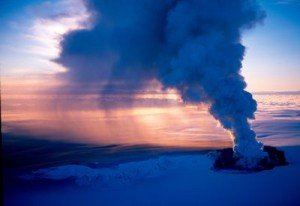Iceland’s Grimsvotn volcano has erupted spilling ash into the atmosphere. While there is some concern that air travel could be affected, experts consider that the eruption will not cause as much disruption as Eyjafjallajökull did last year.
 Our colleagues at the Science Media Centre in London have rounded up commentary from scientists on the eruption and ash cloud.
Our colleagues at the Science Media Centre in London have rounded up commentary from scientists on the eruption and ash cloud.
Feel free to use these comments in your articles. To talk to a New Zealand expert, please contact the New Zealand Science Media Centre (smc@sciencemediacentre.co.nz).
Dr Susan Loughlin, Head of Volcanology at the British Geological Survey, said:
“The Grímsvötn volcano in southeast Iceland started to erupt on 21 May 2011. Its currently emitting a plume of volcanic ash that is being monitored by the Icelandic Meteorological Office. Grímsvötn is the most active volcano in Iceland and is covered by an ice cap, similar to the Eyjafjallajökull volcano which erupted in April 2010. However unlike that eruption, the Grímsvötn volcanic ash is likely to be coarser and fall out closer to the volcano.”
There is more information on the BGS facebook pages for the eruption and ash sampling.
Dr Dave McGarvie, Volcanologist at The Open University, said:
“This eruption has started with much more vigour and violence than the two previous eruptions in 2004 and 1998. Evidence for this is that the eruption column is much higher (15-17 km), whereas it was only 8-10 km high in the two previous eruptions.
“If the eruption continues with its current intensity AND we get unfavourable winds, we could see ash over the UK. But the past two eruptions in 1998 and 2004 from this volcano did not affect UK air travel. The amount of ash reaching the UK is likely to be less than in the 2010 Eyjafjallajokull eruption. In addition, the experience gained from the 2010 eruption – especially by the Met Office, the airline industry, and the engine manufacturers – should mean less disruption to travellers.
“Such a high eruption column sends ash into the lower parts of the next layer of the atmosphere (the stratosphere), where the ash lingers for longer. This is the part of the atmosphere where commercial airliners cruise. But there’s likely to be only a relatively small amount of ash injected into the stratosphere, plus minor re-routing should enable aircraft to avoid zones where the ash is concentrated.
“In summary, this eruption has started off ejecting more material (i.e. a higher mass eruption rate) than the previous two eruptions. If this is Grimsvotn ‘blowing its top’ during an intense but short eruption, then activity will start to diminish in a few days, perhaps a week. More worrying for western Europe would be if this heralds the start of a sustained and lengthy explosive eruption that could last a month or two. After a week has passed (perhaps sooner) we will have a better idea. Whether UK air travel will be affected depends strongly on the amount and type of ash produced as well as how high in the atmosphere it is ejected, on wind direction, and on weather conditions (e.g. rain).”
Dr David Rothery, Open University Volcano Dynamics Group, said:
“Iceland’s Grimsvötn volcano lies beneath the Vatnajokull icecap. It tends to erupt about every ten years (most recently 2004). Because the interval between eruptions is shorter than for Eyjafjallajokull, Grimsvötn’s eruptions tend to be briefer. There is no reason to expect Grimsvötn’s current eruption to produce the volume of finely-fragmented ash that caused such disruption during last year’s Eyjafjallajokull eruption.”
“The ash column height was estimated at 15km to 17 km at 07.00 BST today http://www.metoffice.gov.uk/aviation/vaac/vaacuk.html
and ash dispersal is predicted in a variety of directions around Iceland according to the wind direction at different altitudes:
http://www.metoffice.gov.uk/aviation/vaac/data/VAG_1306043199.png
“However predictions from the Met Office’s London Volcanic Ash Advisory Centre are that ash concentration is unlikely to exceed the 4000 microgrammes per cubic metre safety threshold agreed by the aviation authorities during last year’s Eyjafjallajokull crisis except very close to Iceland.
http://www.metoffice.gov.uk/volcano/public/natlantic.html#D1
“There will be re-routing of some trans-Atlantic flights, but I doubt that it will become necessary to close European airspace. The eruption is also expected to cause local flooding because of escape of meltwater.”